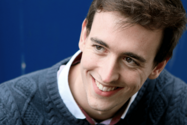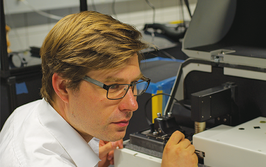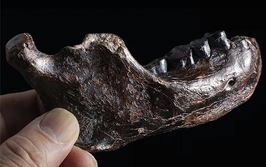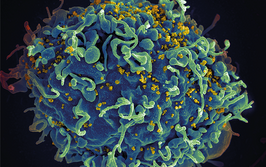
SciX Enters the AI Age
From AI-driven diagnostics to tales of viking treasures, check out our must-see SciX 2024 highlights
James Strachan | | 5 min read
SciX 2024, taking place at the Raleigh Convention Center, is just around the corner. The theme for this year’s conference? “Analytical instrumentation in the age of AI," which is reflected in some of our must-see talks, listed below. But we’ve also picked out some other juicy topics, big-name speakers, and relevant articles from The Analytical Scientist – which we hope will interest even those unable to make the trip to North Carolina.
For those attending, we hope you enjoy the pleasant (70–80 °F) temperatures, blue skies – and spectroscopy!
Sunday
6:00pm – 7:15pm: Joseph D. Viviano – Can an AI Understand a Scientist? (Ballroom A)
SciX kicks off on Sunday, setting the scene for the AI theme with a keynote session from Joseph D. Viviano of the Quebec Artificial Intelligence Institute, who is developing an ecosystem of open source tools to facilitate AI-driven scientific discovery.
Monday
10:50–11:10am: John Kalivas – Synergizing Machine Learning with Human Cognition in Immersive Virtual Reality for Unsupervised Data Exploration (305B)
There were a couple of AI-related talks that caught our eye on the first full day at the conference. In the morning, John Kalivas will discuss the advantages of using immersive virtual reality as an analytics data analysis tool.
Later in the afternoon (4:50–5:10pm), Axel Mosig’s intriguingly titled “Theory is Dead, Long Live Theory” (301B) will defend the claim that scientific explanation makes the unprecedented predictive accuracy of AI-systems in infrared spectroscopy robust and trustworthy.
3:50–4:10pm: J. Michael Ramsey – Translating academic research from the lab to commercial products: a few experiences (303)
J. Michael Ramsey was ranked fourth in our 2024 Power List’s Instrumental Innovators category, and has a wealth of experience utilizing micro- and nano-fabrication strategies to develop devices – many of which have led to commercial success. One wonders what society would be like if we just gave innovators like Michael $1 billion dollars… How would he spend it? Well, we asked him!
“Managing such a huge research grant would be very exciting and a huge responsibility. There are some unstated parameters in the question such as the grant term and whether it is national or international. I would prefer that the $1B award was an endowment that could fund analytical R&D activities in perpetuity and that it was intended to have an international impact. Such a large award would certainly require a term of at least 10 years to efficiently utilize the capital resources. I would first…” Read more here.
Tuesday
1:30–1:50pm: Duncan Graham – Point of use SERS for Detection of Antimicrobial Resistance (302B)
Duncan Graham is one of the world’s leading researchers in the SERS field, his talk, where he’ll discuss a new capability to detect antimicrobial resistance using point of use SERS, should be worth a look. Last year, we asked Duncan about developments in SERS of the past decade, and where he thinks the field will take us next.
“In the future, I hope we will see SERS applied in several new and unique ways – such as non-destructive, real-time analysis of multiple species simultaneously at ultra sensitive concentrations and in a quantitative manner. If this can be achieved, we’ll see greater advances in SERS from the research laboratories into the hands of the end user – ultimately benefiting society. SERS is finally being acknowledged as a promising technique – one that is going to deliver on several meaningful applications. But…” Read more.
3:50–5:30pm: Juergen Popp – AI-Driven Multimodal Chemical Imaging for Biomedical Diagnostics (302A)
If we had to pick one researcher tailor made for the AI/spectroscopy theme, it may well be Juergen Popp. You can read his thoughts on Raman spectroscopy’s AI-enabled future here:
“As the number of Raman datasets and biomedical Raman studies increases, the application of deep learning approaches using neural networks is rapidly entering Raman spectroscopy and becoming increasingly important. And with the growth of AI, we could be on the cusp of a powerful synergy that incorporates both AI and deep learning in Raman spectroscopy. This combination could be the missing link necessary to ensure Raman is routinely used for clinical applications.”
Wednesday
10:30am–12:10pm: Hunter B. Andrews – Novel Approaches to and Applications of LIBS (Session) (302B)
Wednesday morning’s LIBS session features some exciting applications, starting with lunar surface exploration (Samuel Clegg, Los Alamos National Lab, 10:30am), and followed by LIBS plasmas on Mars (Henry Manelski, Purdue, 10:50am).
10:50–11:10am: Christopher D. Brown – Handheld mass spectrometry analysis of surface-dwelling and airborne fentanyl analogs and CWA (306A)
As usual, there are quite a few interesting mass spectrometry talks at SciX. Christopher Brown is co-founder (along with Michael Ramsey, mentioned above) and CTO of 908 Devices – which won our very first Innovation Awards back in 2013 for the development of the first handheld mass spectrometer. Last year, we spoke with CEO Kevin Knopp about the limits of mass spec miniaturization. Here, Chris’ talk on continuous aerosol analysis with a handheld mass spectrometer looks interesting!
1:30–3:10pm: Ioan Notingher – Raman in Regenerative Medicine (Session) (302C)
We’re also interested in Ioan’s session on Raman’s role in regenerative medicine – nanoparticle gene delivery, cartilage health, and high-throughput cellular imaging are all covered.
Thursday
11:30–11:50am: Gry H. Barfod – Tales of golden glass and viking treasures (306C)
We’re suckers for historical spectroscopic applications at The Analytical Scientist, and Gry’s talk on what the use of geochemical methods can reveal about the origin of viking glass beads fits the bill! In a similar vein, there are a number of interesting-sounding talks pertaining to ancient texts. You wouldn’t usually find a speaker from a Theological Seminary at an analytical conference, but W. Andrew Smith (Shepherds) will be there at 2:30pm (306C) to discuss “Revelation and Discovery in Biblical Manuscript Imaging: Enhancing Textual Data Collection for Critical Editions”. Moreover, P.R. Mukund will give a talk (306C) at 1:50pm on the “Preservation of Ancient Hindu Texts using Novel Technologies.”
1:50–2:10pm: Richard A. Crocombe – Portable Raman Spectrometers, Fluorescence and Lego Blocks (306B)
Richard Crocombe is a portable spectroscopy pioneer and we’ve covered his innovative work using lego blocks in past newsletters – his team uses them to evaluate fluorescence avoidance and/or mitigation methods. In addition, he recently wrote an article for The Analytical Scientist on the future of optical spectroscopy and diagnosis:
“Looking towards the future of diagnostics, it’s likely that optical spectroscopic techniques will be available in cost-effective, miniature packages with an emphasis on the consumer rather than the clinical space – such as smart watches and other wearables. Of course, clinical applications are guaranteed to follow, but I believe we’re at least 10 years from this integration. Looking even further into the future…” Read more.

Over the course of my Biomedical Sciences degree it dawned on me that my goal of becoming a scientist didn’t quite mesh with my lack of affinity for lab work. Thinking on my decision to pursue biology rather than English at age 15 – despite an aptitude for the latter – I realized that science writing was a way to combine what I loved with what I was good at.
From there I set out to gather as much freelancing experience as I could, spending 2 years developing scientific content for International Innovation, before completing an MSc in Science Communication. After gaining invaluable experience in supporting the communications efforts of CERN and IN-PART, I joined Texere – where I am focused on producing consistently engaging, cutting-edge and innovative content for our specialist audiences around the world.

















